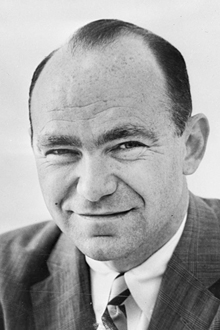Sam Hunter, Rose Art Museum's first director, dies
 Photo/Robert D. Farber University Archives & Special Collections
Photo/Robert D. Farber University Archives & Special CollectionsSam Hunter
Sam Hunter, founding director of the Rose Art Museum, whose keen insights into the art of his day allowed him to build the museum’s acclaimed collection of modern and contemporary art, died on July 27 in Princeton, N.J. He was 91.
Financed by a $50,000 gift from Leon Mnuchin and his wife, Harriet Gevirtz-Mnuchin, Hunter made acquisitions in the early 1960s that established the Rose as a major force in the art world. The works he collected, masterpieces by Jasper Johns, Robert Rauschenberg, Roy Lichtenstein, Andy Warhol and other leading artists, form the core of the Rose’s beloved collection and continue to set the tone for the museum’s collecting and exhibition practices.
“Sam Hunter played an integral role in the early days of the Rose Art Museum, and his prescient purchases propelled the museum into the consciousness of the art world just a few years after its founding,” Brandeis President Frederick M. Lawrence said. “The way in which he built the early collection, a discrete number of outstanding acquisitions, none for more than $5,000, is one of the iconic stories of the early years of Brandeis University. His impact on the Rose in particular and the university in general continues to this day.”
Hunter came to Brandeis in 1960 as director of the Poses Institute of Fine Arts, and shortly thereafter became the first director of the Rose. Organizers of the 1962 World’s Fair in Seattle approached him about curating an exhibition for the Fine Arts Pavilion. The resulting collection of 114 works from 87 artists, including many by artists whose work he would later purchase for the Rose, was subsequently displayed at Brandeis.
In late 1962, Mnuchin called from New York to announce that he and his wife had inherited $50,000, which they wished to donate to the Rose to fund a contemporary art collection. Hunter and Mnuchin immediately began exploring the galleries of New York, often with Robert Scull, a friend of Mnuchin and a prominent collector of Pop Art.
“The guiding principle of the selection was individual quality rather than tendency,” Hunter wrote for the brochure accompanying the collection’s exhibition. “As a matter of policy, the collection focused on younger artists with only a token representation of the older generation. … Abstract Expressionism is the collection’s point of departure, taken at a point of subtle but significant transition.”
Although Hunter and Mnuchin set a limit of $5,000 per painting, they managed to gather early and important works by Claes Oldenburg, Jim Dine, Tom Wesselmann, James Rosenquist, Adolph Gottlieb, Robert Indiana, Ellsworth Kelly, Marisol, Morris Louis, Johns, Rauschenberg, Lichtenstein, Warhol and many others.
“It is very difficult to imagine a more significant founding director than Sam Hunter has proved to be,” said Christopher Bedford, the Henry and Lois Foster Director of the Rose. “Just as Brandeis established its academic reputation with incredible rapidity, so Sam made sure the same happened to the Rose through the acquisitions he made and the exhibitions he organized. The status we enjoy today is in large part due to his vision in the 1960s.”
Bedford also pointed out that Hunter was a towering figure in both curatorial and academic spheres. “He had one foot in the world of museums and one foot in the world of scholarship, a model for how the Rose thinks of itself today,” he said. “He was as much a director/curator as he was a scholar, and that dual commitment continues to represent the Rose in the work we do today.
Upon learning of Hunter’s death, Bedford decided to name the Rose’s newly-established emerging artists fund in his memory. “The fund lacked a name,” Bedford said, “and today it became very apparent what the name of the fund should be. It seems incongruous to apply this term today, but the Gevirtz-Mnuchin fund was an emerging artists fund in the early 1960s: Roy Lichtenstein, Jasper Johns, and Ellsworth Kelley were the emerging artists of their day. It’s only just that we would perpetuate Hunter’s legacy with a fund that boasts his name.”
A native of Springfield, Mass., Hunter graduated from Williams College in 1943. He served in the U.S. Navy from 1943-46, rising to the rank of lieutenant junior grade and receiving five battle stars.
Hunter began his professional art career in 1947, when he joined The New York Times as art critic for a two-year stint. He studied at the University of Florence through the Hubbard Hutchinson Fellowship, earning a certificate of studies in 1951. He spent a year as an editor with art publisher Harry N. Abrams Inc. before serving as editor of Arts Magazine.
In 1955, he was appointed associate professor of art history at the University of California, Los Angeles, but left in 1956 to become curator of painting and sculpture at the Museum of Modern Art in New York. Two years later, he moved to the Minneapolis Institute of Arts as chief curator and acting director.
After leaving Brandeis in 1965, he was appointed director of the Jewish Museum and lectured as a visiting professor at Cornell. In 1969, he became professor of art history at Princeton and curator of modern art at the university’s art museum. He retired from Princeton as professor emeritus in 1991.
He is survived by his wife, Maïa; their son, Harry; two daughters, Emmy and Alexa, from his previous marriage to Edys Merrill; and one grandchild, Isabella.
A funeral service was scheduled for noon on July 30 in the Princeton University Chapel.





